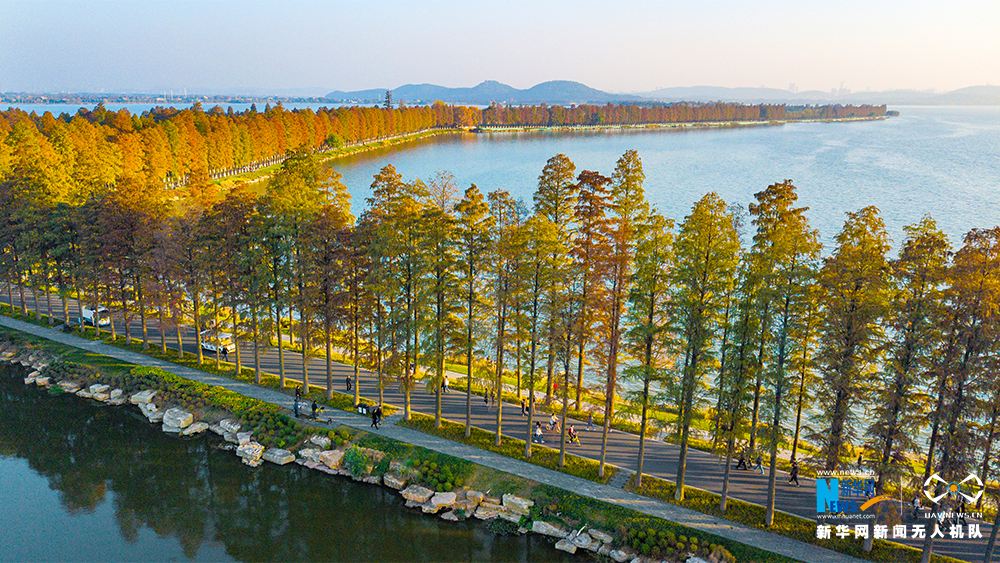


The greenway at the Donghu Lake, Wuhan, central China’s Hubei province. (Photo/Xinhua)
China created 14,000 kilometers of greenway in 2018, bringing the country's total to 56,000 kilometers, according to data released by the country’s Ministry of Housing and Urban-Rural Development.
The greenway network has linked the “green” resources of the urban and rural areas, forming a complete system with public transportation roads alongside pedestrian and cycle paths. It will help hold water and soil and purify the air, as well as alleviate the urban heat island effect.
Many cities have restored the ecological environment in areas where they extended greenways. They also regulated pollution-emitting industries and improved regional ecology.
The greenway construction started from the Pearl River Delta, and has developed nationwide in the last 10 years, said Wang Panyan, vice president of the China Urban Construction Design and Research Institute Co., Ltd.
Fuzhou, capital of southeastern China’s Fujian province, has built 400 kilometers of greenway along its rivers and 175 kilometers over mountains. It has also created 168 parks in the city.
China’s greenways offer a path of history and culture. In east China’s Zhejiang province, these green roads connect 19 national-level and 40 provincial-level tourist sites, as well as 635 traditional villages at national level and 406 at provincial level, introduced Zhang Yi, deputy head of the Department of Housing and Urban-rural Development of Zhejiang Province.
Clear waters and lush mountains are invaluable assets, and the greenways are generating profits for the people.
The greenway along Qiandao Lake in Chun'an County, Zhejiang has attracted about 17 million visitors, earning around 20 billion yuan ($2.97 billion) last year, Zhang said.
According to the Ministry of Housing and Urban-Rural Development, it will keep improving greenway construction and build a greenway network that connects all ecological factors of the city.
 Fire brigade in Shanghai holds group wedding
Fire brigade in Shanghai holds group wedding Tourists enjoy ice sculptures in Datan Town, north China
Tourists enjoy ice sculptures in Datan Town, north China Sunset scenery of Dayan Pagoda in Xi'an
Sunset scenery of Dayan Pagoda in Xi'an Tourists have fun at scenic spot in Nanlong Town, NW China
Tourists have fun at scenic spot in Nanlong Town, NW China Harbin attracts tourists by making best use of ice in winter
Harbin attracts tourists by making best use of ice in winter In pics: FIS Alpine Ski Women's World Cup Slalom
In pics: FIS Alpine Ski Women's World Cup Slalom Black-necked cranes rest at reservoir in Lhunzhub County, Lhasa
Black-necked cranes rest at reservoir in Lhunzhub County, Lhasa China's FAST telescope will be available to foreign scientists in April
China's FAST telescope will be available to foreign scientists in April "She power" plays indispensable role in poverty alleviation
"She power" plays indispensable role in poverty alleviation Top 10 world news events of People's Daily in 2020
Top 10 world news events of People's Daily in 2020 Top 10 China news events of People's Daily in 2020
Top 10 China news events of People's Daily in 2020 Top 10 media buzzwords of 2020
Top 10 media buzzwords of 2020 Year-ender:10 major tourism stories of 2020
Year-ender:10 major tourism stories of 2020 No interference in Venezuelan issues
No interference in Venezuelan issues
 Biz prepares for trade spat
Biz prepares for trade spat
 Broadcasting Continent
Broadcasting Continent Australia wins Chinese CEOs as US loses
Australia wins Chinese CEOs as US loses